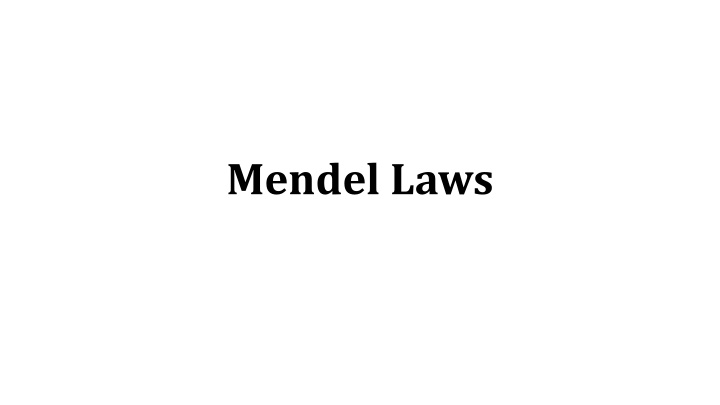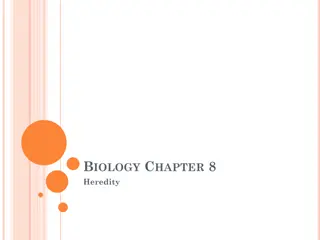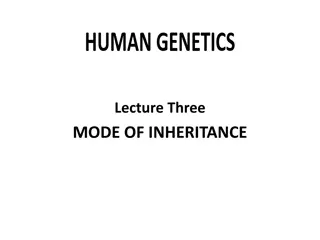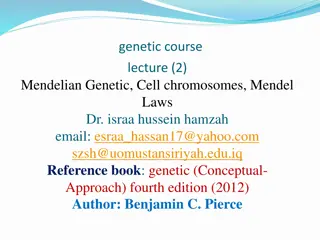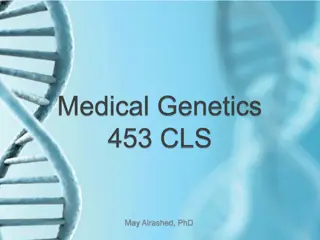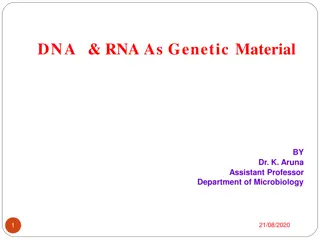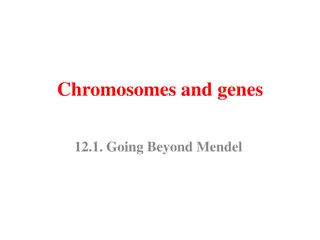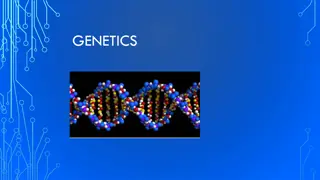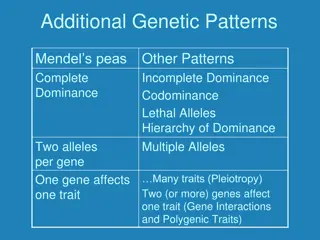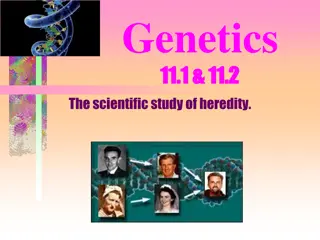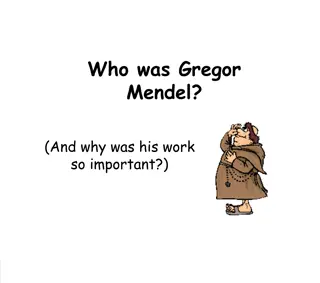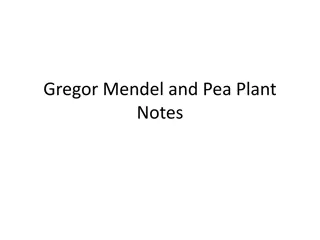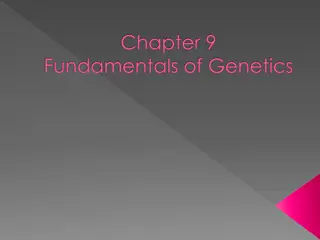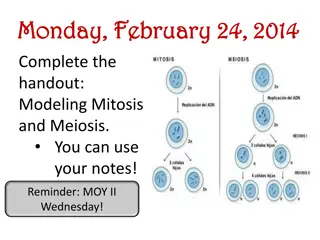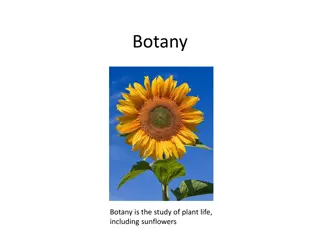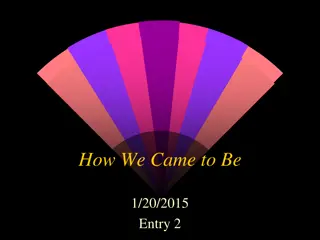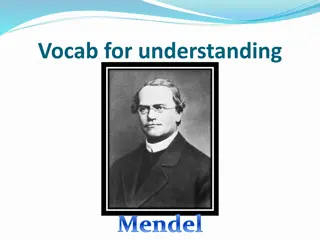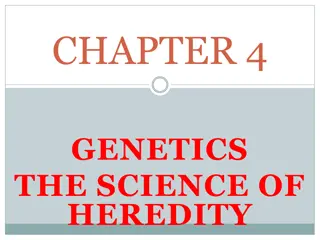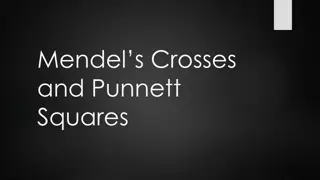Life and Work of Mendel: From Struggles to Discoveries
Johann Greogar Mendel, born in 1822 in Silesia, faced various challenges in his early life but went on to make groundbreaking discoveries in genetics. Despite initial setbacks, he pursued higher education, delved into blending inheritance, and introduced key concepts like genotype and homozygous traits. Mendel's laws revolutionized the understanding of heredity and paved the way for modern genetics.
Download Presentation

Please find below an Image/Link to download the presentation.
The content on the website is provided AS IS for your information and personal use only. It may not be sold, licensed, or shared on other websites without obtaining consent from the author.If you encounter any issues during the download, it is possible that the publisher has removed the file from their server.
You are allowed to download the files provided on this website for personal or commercial use, subject to the condition that they are used lawfully. All files are the property of their respective owners.
The content on the website is provided AS IS for your information and personal use only. It may not be sold, licensed, or shared on other websites without obtaining consent from the author.
E N D
Presentation Transcript
Life of Mendel Johann Greogar Mendel, 1822, Silesia Father name: Anton, a poor family, crop sharing family Two Sister Victoria and Teresa, he was the youngest Mendel was weak, not robust, most time sick, not fit for farming, so he was sent to boarding school to become a teacher
1838, father lost his legs, so he had to come back to look the farm, he was a patient of melancholia (current day depression) and went to bed for six months. Victoria got married and her husband got the farm. Father gave money to Teresa, and Teresa sent Mendel to Brno (Czech republic) to pursue his studies and he joined the monastery of Saint Thomas Abbot Napp made him a teacher in church school, he was good but the parent complained that he has no credentials
There was a test for teaching credentials which he failed because he has test anxiety He was sent to Vienna to university, he has three important teachers Unger, Plant anatomist Doppler, Physicist Ettinghousen, Mathematician He failed the exams, came back, went to bed for six months.
He was made TA and he worked on Blending inheritance (Blending inheritance is important because it give you better results as compared to the species itself). Most of the land around Brno was owned by the church, so the church was interested in blending to make money. Known: Blending inheritance Unknown: Chromosome, Mitosis, Meiosis, Ploidy, DNA Unger was in contact with church, making hybrids Companies had catalogues providing true varieties plants (we now would say that it is homozygous at all loci)
Vocabulary terms There are a few important terms you should know before diving into Mendel's Laws. GENOTYPE = the genes present in the DNA of an organism. We will use a pair of letters (ex: Tt or YY or ss, etc.) to represent genotypes for one particular trait. There are always two letters in the genotype because (as a result of sexual reproduction) one code for the trait comes from mama organism & the other comes from papa organism, so every offspring gets two codes (two letters). Now, turns out there are three possible GENOTYPES two big letters (like "TT"), one of each ("Tt"), or two lowercase letters ("tt").
When we have two capital or two lowercase letters in the GENOTYPE (ex: TT or tt) it's called HOMOZYGOUS ("homo" means "the same"). Sometimes the term "PURE" is used instead of homozygous. When the GENOTYPE is made up of one capital letter & one lowercase letter (ex: Tt) it's called HETEROZYGOUS ("hetero" means "other"). Just to confuse you, a heterozygous genotype can also be referred to as HYBRID. OK?
PHENOTYPE: how the trait physically shows-up in the organism. Examples of phenotypes: blue eyes, brown fur, striped fruit, yellow flowers. ALLELES = alternative forms of the same gene. Alleles for a trait are located at corresponding positions on homologous chromosomes.
Selection of Traits Traits Varieties Seed shape Round Vs wrinkled Seed color Yellow Vs green Flower color Purple Vs White Pod Shape inflated Vs pinched Flower position Apical Vs terminal Stem length Long Vs short
Monohybrid Crosses Mate Tall plant with Dwarf Plant, in F1 all were Tall In F2 both tall and dwarf Ratio 224: 705 = 1:3 F1 told him dominance and recessiveness He established the dominant and recessiveness for all traits Yellow seeds with green, F1 yellow (674), in F2 155 (yellow), 353 (both) and 166 (green), so 1:2:1
Mendel first law Each member of a gene pair has an equal probability of being in a gamete and a gamete gets only 1. So he should get the credit for discovery of diploidy of peas and haploidy of gametes, although no text mention it.
Dihybrid cross Round green seed with wrinkled yellow Round yellow: 9 Round green: 3 Wrinkled yellow: 3 Wrinkled green: 1 Round Vs wrinkled: 12:4 = 3:1 Yellow Vs green: 12:4 = 3:1
Mendel Second law During gamete formation, the segregation of one gene pair is independent of all other. Feb 21, 1865 philosophical society of natural history of Brno March 8, 1865, he published his work, got 40 prints, sent to Darwin (he didn't study it, although to understand natural selection, he should have)
Hieracium, Van Nageli, Hieracium produce mitotic flowers so Mendel was not able to prove his observations. He published his next paper on how he was not able to reproduce his results in Hieracium Anselm Rambousek Died in 1882 Rediscovery of Mendel Laws Hugo Devries (He had the paper of Mendel), Carl Carrens (Married the niece of Von Nageli, owned his library)
PROBLEMS ON MENDELS LAW OF SEGREGATION Note: In peas, tall (T) parent habit is dominant over dwarf (t) 1. If a plant homozygous for tall is crossed with one homozygous for dwarf, what will be the appearance of a. F1 b. F2 c. of the offspring of a cross of f1 with its tall parent d. with its dwarf parent 2. Let the allele for tall be represented by T and the allele for dwarfness by t. What will be the gametes produced by the parent and the height of the offspring (tall or dwarf) from each of the following crosses. a. TT X Tt b. Tt X tt c. Tt X Tt
3. A tall plant crossed with a dwarf one produces offspring of which about one-half are tall and one-half dwarf, what are the genotypes of the parents.
Problems On Mendels Law Of Independent Assortment Note: In Mouse Rough Coat (R) habit is dominant over Smooth Coat (r) and Black Coat Color (B) is dominant over White Coat Color (b) 1. If a homozygous rough black mouse is crossed with one homozygous for smooth white, what will be the appearance of a. F1 b. F2 c. of the offspring of a cross of f1 with homozygous rough black mouse d. of the offspring of a cross of f1 with homozygous smooth white 2. How many of the offsprings in F2 generation of Q # 1 will be homozygous for both rough and black character.
3. Seed Color : Yellow = G; Green = g Seed Shape: Round = W ; Wrinkled = w If a homozygous Yellow Round is crossed with one homozygous for Green Wrinkled, what will be the appearance of a. F1 b. F2 c. of the offspring of a cross of f1 with homozygous Yellow Round d. of the offspring of a cross of f1 with homozygous Green Wrinkled
